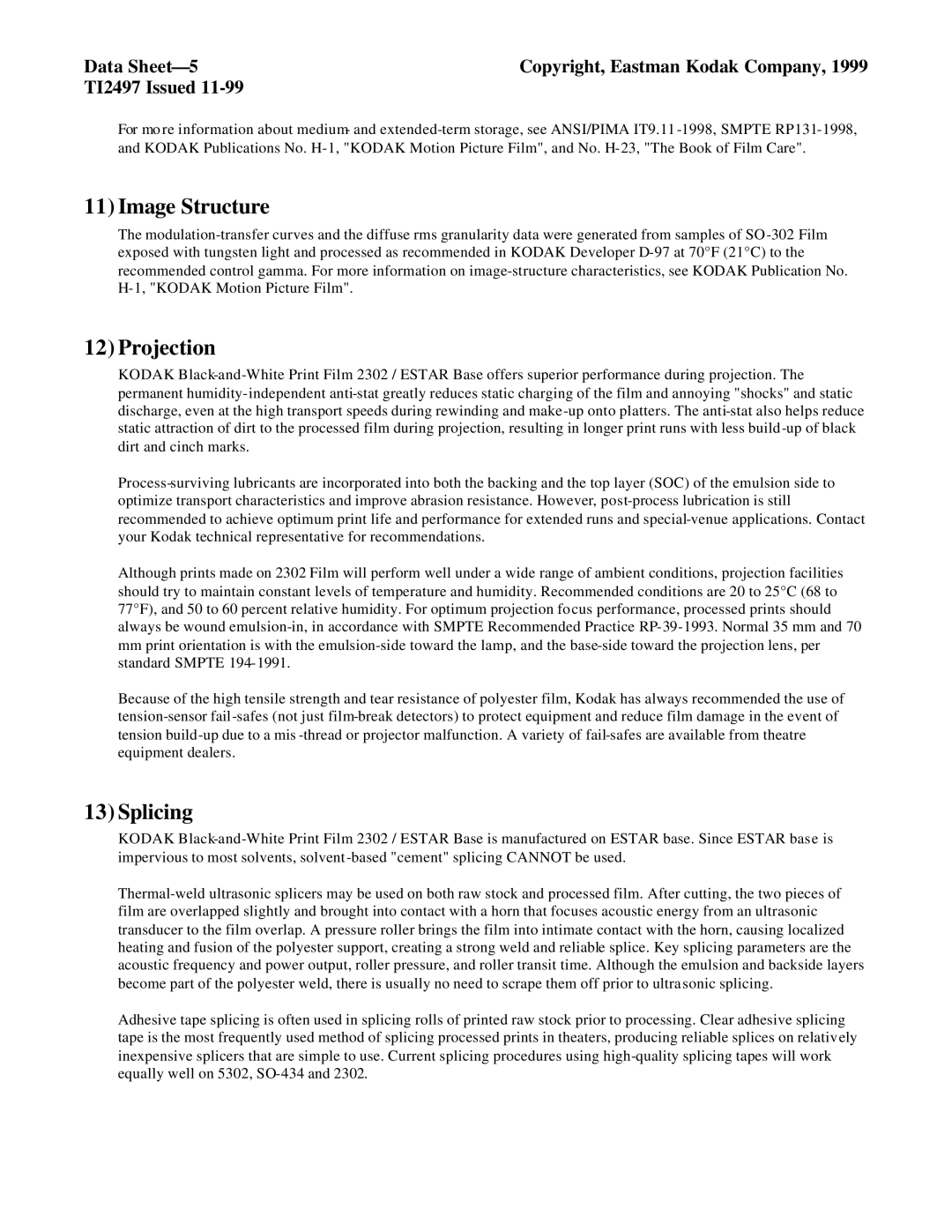Data Sheet—5 | Copyright, Eastman Kodak Company, 1999 |
TI2497 Issued 11-99 | |
For mo re information about medium- and extended-term storage, see ANSI/PIMA IT9.11 -1998, SMPTE RP131-1998, and KODAK Publications No. H-1, "KODAK Motion Picture Film", and No. H-23, "The Book of Film Care".
11) Image Structure
The modulation-transfer curves and the diffuse rms granularity data were generated from samples of SO -302 Film exposed with tungsten light and processed as recommended in KODAK Developer D-97 at 70°F (21°C) to the recommended control gamma. For more information on image-structure characteristics, see KODAK Publication No. H-1, "KODAK Motion Picture Film".
12) Projection
KODAK Black-and-White Print Film 2302 / ESTAR Base offers superior performance during projection. The permanent humidity-independent anti-stat greatly reduces static charging of the film and annoying "shocks" and static discharge, even at the high transport speeds during rewinding and make -up onto platters. The anti-stat also helps reduce static attraction of dirt to the processed film during projection, resulting in longer print runs with less build -up of black dirt and cinch marks.
Process-surviving lubricants are incorporated into both the backing and the top layer (SOC) of the emulsion side to optimize transport characteristics and improve abrasion resistance. However, post-process lubrication is still recommended to achieve optimum print life and performance for extended runs and special-venue applications. Contact your Kodak technical representative for recommendations.
Although prints made on 2302 Film will perform well under a wide range of ambient conditions, projection facilities should try to maintain constant levels of temperature and humidity. Recommended conditions are 20 to 25°C (68 to 77°F), and 50 to 60 percent relative humidity. For optimum projection focus performance, processed prints should always be wound emulsion-in, in accordance with SMPTE Recommended Practice RP-39-1993. Normal 35 mm and 70
mmprint orientation is with the emulsion-side toward the lamp, and the base-side toward the projection lens, per standard SMPTE 194-1991.
Because of the high tensile strength and tear resistance of polyester film, Kodak has always recommended the use of tension-sensor fail-safes (not just film-break detectors) to protect equipment and reduce film damage in the event of tension build -up due to a mis -thread or projector malfunction. A variety of fail-safes are available from theatre equipment dealers.
13) Splicing
KODAK Black-and-White Print Film 2302 / ESTAR Base is manufactured on ESTAR base. Since ESTAR bas e is impervious to most solvents, solvent -based "cement" splicing CANNOT be used.
Thermal-weld ultrasonic splicers may be used on both raw stock and processed film. After cutting, the two pieces of film are overlapped slightly and brought into contact with a horn that focuses acoustic energy from an ultrasonic transducer to the film overlap. A pressure roller brings the film into intimate contact with the horn, causing localized heating and fusion of the polyester support, creating a strong weld and reliable splice. Key splicing parameters are the acoustic frequency and power output, roller pressure, and roller transit time. Although the emulsion and backside layers become part of the polyester weld, there is usually no need to scrape them off prior to ultrasonic splicing.
Adhesive tape splicing is often used in splicing rolls of printed raw stock prior to processing. Clear adhesive splicing tape is the most frequently used method of splicing processed prints in theaters, producing reliable splices on relatively inexpensive splicers that are simple to use. Current splicing procedures using high-quality splicing tapes will work equally well on 5302, SO-434 and 2302.
